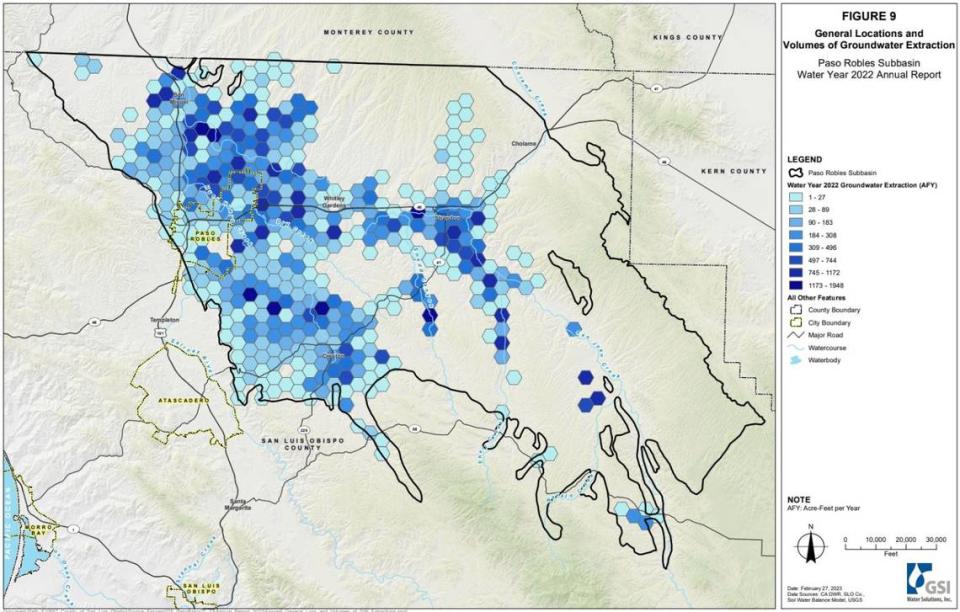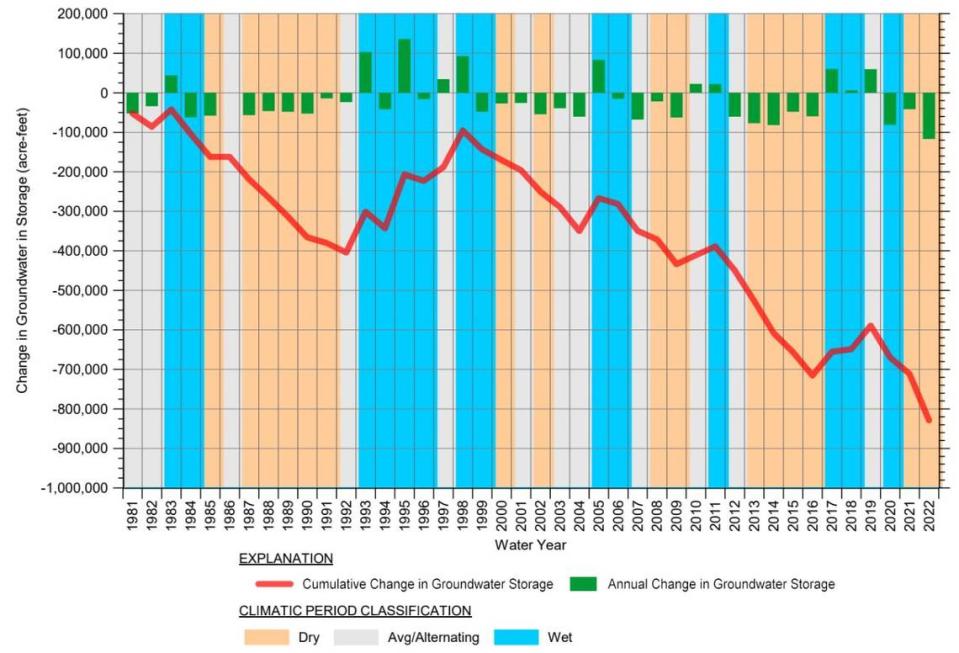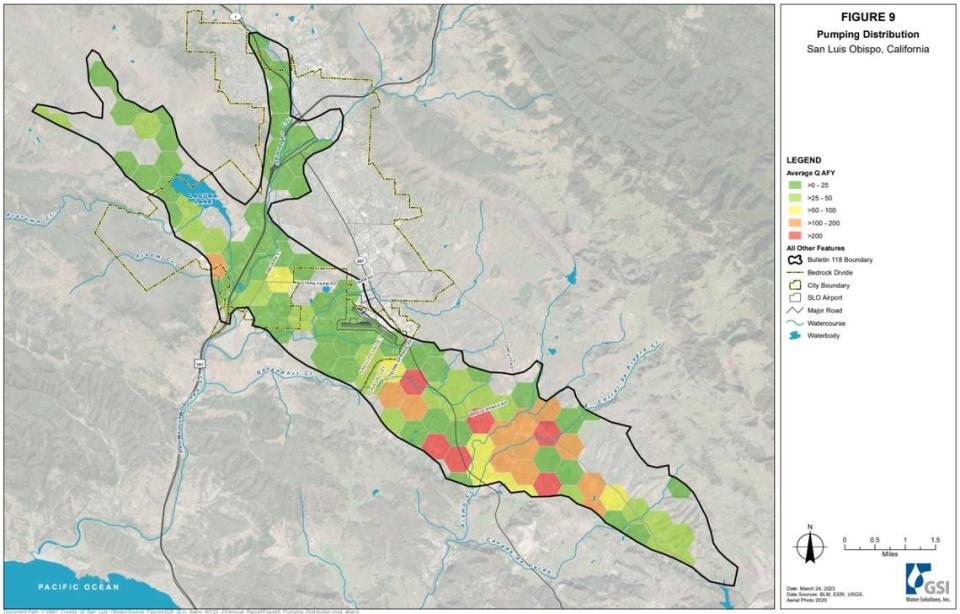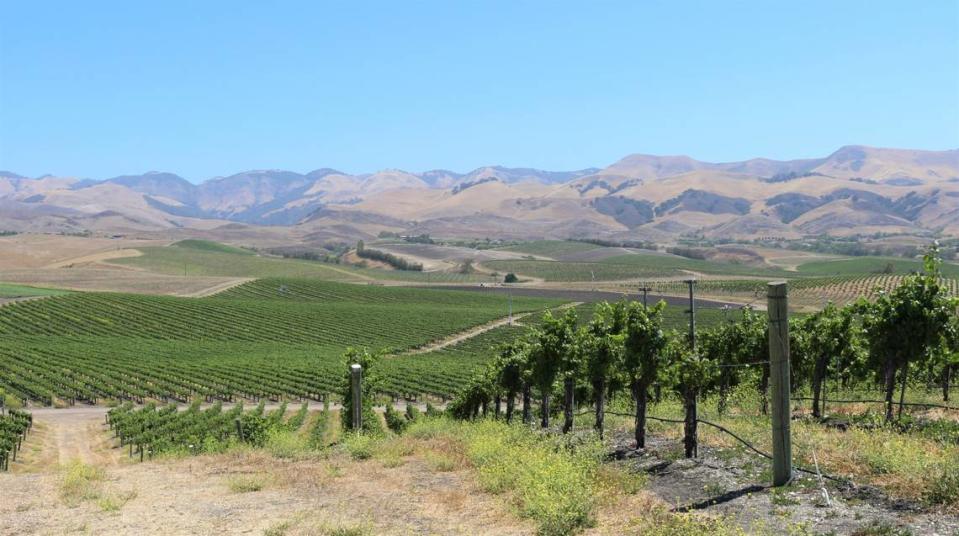SLO County groundwater supplies are in trouble after years of drought, reports show
San Luis Obispo County reports show how the groundwater basins in San Luis Obispo and Paso Robles suffered after years of continuous, severe droughts.
The annual reports, which analyzed the 2022 water year running from Oct. 1, 2021, through Sept. 30, 2022, were submitted to the California Department of Water Resources in March. The plans must be sent per the state’s Sustainable Groundwater Management Act, which aims to bring overdrafted basins into balance.
The San Luis Obispo and Paso Robles groundwater basins have both been in critical condition for several years and need restorative efforts to ensure future generations have water, according to the Department of Water Resources.
And despite groundwater sustainability plans for both of the basins being recently implemented, back-to-back years of severe drought further depleted the already-shrinking water sources.
“If we don’t reduce pumping or bring in supplemental water ... we would need a number of wet years, like we just had, to recover,” said Blaine Reely, San Luis Obispo County’s groundwater sustainability director.
Paso Robles groundwater basin shows severe declines during drought
The Paso Robles groundwater basin in northern San Luis Obispo County saw the worse declines out of the two, according to the reports submitted to the state.
In total, 87,200 acre-feet of water was extracted from the basin during the last water year. For context, one acre-foot of water is about 325,851 gallons, or enough to supply two average households for a year.
Most of that consumption, 80,200 acre-feet or 92%, came from agriculture users. That’s a 4,700 acre-foot increase from the previous water year, according to the basin report.
During the 2022 water year, there were 37,604 irrigated acres of land in the Paso Robles groundwater basin — 32,683 of which were wine grape vineyards, accounting for nearly 9% of the total land overlying the basin, according to the basin report.

The rest of the basin’s consumption came from the city of Paso Robles and rural homeowners and small public water systems, according to the report.
The city’s groundwater use increased by about 429 acre-feet in the report’s water year to 1,982 acre-feet while the rural homeowners and small public water systems stayed level at 5,060 acre-feet, the report says.
The Paso Robles groundwater basin’s sustainable yield — or how much water can be pumped while ensuring the source is not depleted — is about 61,100 acre-feet of water. That means pumping during the 2022 water year far exceeded how much water should be taken out.
The overpumping combined with severe drought resulted in a total storage loss of 117,100 acre-feet in the basin, according to the report. That’s up from a 41,500 acre-foot loss in 2021, an 80,800 acre-foot loss in 2020, and a 59,700 acre-foot gain in 2019, the report says.
Because the water year ends Sept. 30, 2022, it does not include the historic rains from this past winter.

San Luis Obispo groundwater basin also suffers during drought
In San Luis Obispo, the basin’s condition also deteriorated during the drought years.
The basin, which stretches under San Luis Obispo and Edna Valley, had 6,360 acre-feet pumped during the 2022 water year.
Agriculture users accounted for 5,070 acre-feet while public water system and rural homeowners used 1,290 acre-feet — both an increase of 40 acre-feet from the year before, according to the basin’s annual report.
The San Luis Obispo groundwater basin has a sustainable yield of 5,800 acre-feet, the report says.
Most of the pumping happened in the Edna Valley area because that is where most of the wells are located to supply water for vineyards, orchards and vegetable farming.
In total, the San Luis Obispo groundwater basin lost about 1,663 acre-feet of groundwater in storage due to the overpumping and severe drought. That’s better than in 2021 when 5,530 acre-feet were lost, but worse than in 2020 when 540 acre-feet were lost, according to the report.
“The basin is in moderate overdraft. We have to correct that — and it’s agricultural pumping, for the most part, that is associated with that over-pumping,” Reely said. “And so those are the folks that we have to work with to manage that and to reduce that groundwater pumping to get to sustainability.”

Plans in place to improve groundwater basin health
Both basins have groundwater sustainability plans that aim to improve basin conditions within the next 40 years.
Because the plans were approved by the state in March, Reely said he doesn’t expect any major improvements to show quite yet, despite some sustainability efforts being underway for a few years already. However, changes such as improved water level data from an increase in monitoring wells have already helped create more accurate reports, he said.
One major and recent change for the Paso Robles groundwater basin was the removal of certain use restrictions on Lake Nacimiento’s water by the California State Water Board in April.
Now, the lake’s water can be used by agricultural users.
Reely said that the surplus water from Nacimiento could be blended with water from the city of Paso Robles’ recycled water plant to create good irrigation water for vineyards. Currently, a technical advisory committee is sketching out the details of how that system will work, he added.
The groundwater sustainability plans also aim to cut down on groundwater pumping by incentivizing farmers to use less water by fallowing fields or converting to dry farming, Reely said.
“I think there’s going to be more and more activity on implementing the basins’ plans this year,” Reely said. “We have a long way to go.”


